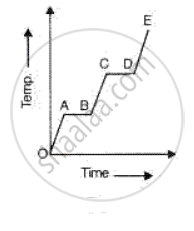Advertisements
Advertisements
प्रश्न
The difference between the two molar specific heats of gas is 9000 J/kg K. If the ratio of the two specific heats is 1.5, calculate the two molar specific heats.
उत्तर
Given,
Cp - Cv = 9000 J/kg K
`"C"_"p"/"C"_"v" = 1.5`
Cv = ?
Cp = ?
`"C"_"p"/"C"_"v" = 1.5`
`"C"_"p" = 1.5 " C"_"v"`
`"C"_"p" - "C"_"v" = 9000`
`1.5 " C"_"v" - "C"_"v" = 9000`
`0.5 " C"_"v" = 9000`
`therefore "C"_"v" = 9000/0.5`
= 18000 J/kg k
`therefore "C"_"p" = 9000 + "C"_"v"`
= 9000 + 18000
= 27000 J/kg k
∴ Two molar specific heats ore 18000 J/kg k and 27000 J/kg k.
APPEARS IN
संबंधित प्रश्न
You have a choice of three metals A, B, and C, of specific heat capacities 900 Jkg-1 °C-1, 380 Jkg-1 °C-1 and 460 Jkg-1 °C-1 respectively, to make a calorimeter. Which material will you select? Justify your answer.
During the phase change does the average kinetic energy of the molecules of the substance increase?
Name a liquid which has the highest specific heat capacity.
What do you mean by the following statement?
The heat capacity of a body is 50 JK-1?
What do you mean by the following statement?
The specific heat capacity of copper is 0. 4 Jg-1 K-1?
Discuss the role of high specific heat capacity of water with reference to climate in coastal areas.
Water is used in hot water bottles for fomentation. Give a reason.
The S.I. unit of specific heat capacity is ______.
An electric heater of power 600 W raises the temperature of 4.0 kg of a liquid from 10.0℃ to 15.0℃ in100 s. Calculate:
- the heat capacity of 4.0 kg of liquid,
- the specific heat capacity of the liquid.
Explain the meaning of green house effect.
What impact will global warming have on the health of the affected population?
State three ways to minimize the global warming.
What is meant by specific heat capacity?
How will you prove experimentally that different substances have different specific heat capacities?
Indian style of cooling drinking water is to keep it in a pitcher having porous walls. Water comes to the outer surface very slowly and evaporates. Most of energy needed for evaporation is taken from the water itself and the water is cooled down. Assume that a pitcher contains 10 kg of water and 0.2 g of water comes out per second. Assuming no backward heat transfer from the atmosphere to the water, calculate the time in which the temperature decrease by 5°C. Specific heat capacity of water = 4200 J kg−1 °C−1 and latent heat of vaporization of water = 2.27 × 106 J kg−1.
A substance is heated at a constant rate from a low temperature to a high temperature. A graph of temperature against time is shown in the figure. Which part or parts of the graph correspond(s) to the substance existing in two states?

An equal quantity of heat is supplied to two substances A and B. The substance A shows a greater rise in temperature. What can you say about the heat capacity of A as compared to that of B?
Is it possible to condense the water formed, back to ice by adding ice at 0°C. Explain with reason.
Derive Mayer’s relation.
Numerical Problem.
What is the heat in joules required to raise the temperature of 25 grams of water from 0°C to 100°C? What is the heat in Calories? (Specific heat of water = `(4.18"J")/("g"°"C")`
Heat is applied to a rigid diatomic gas at constant pressure. The ratio ΔQ : ΔU : ΔW is ______.
The molar specific heat of an ideal gas at constant pressure and constant volume is 'Cp' and 'Cv' respectively. If 'R' is the universal gas constant and the ratio 'Cp' to 'Cv' is 'γ' then CV = ______.
Two metals A and B have specific heat capacities in the ratio 2:3. If they are supplied same amount of heat then
If the mass ratio of metal A and metal B is 3:5 then calculate the ratio in which their temperatures rise.
Water has the lowest specific heat capacity.
Match the following
| 1. | Specific heat capacity | a. | Dewar bottle |
| 2. | Calorimeter | b. | Lavoisier and Simon |
| 3. | Vacuum flask | c. | J Kg-1 K-1 |
| 4. | Ice – calorimeter | d. | Heat capacity |
What is the amount of heat required to raise the temperature of 5 kg of iron from 30°C to 130°C? Specific heat capacity of iron = 483 Jkg-1C-1.
The molar specific heats of an ideal gas at constant pressure and volume are denoted by Cp and Cv, respectively. If `gamma = "C"_"p"/"C"_"v"` and R is the universal gas constant, then Cv is equal to ______.
